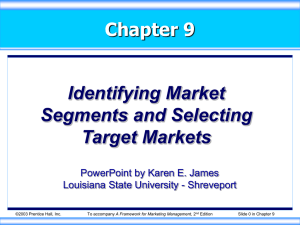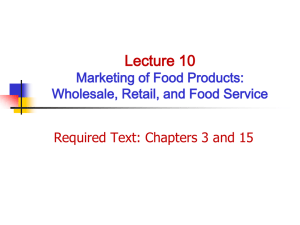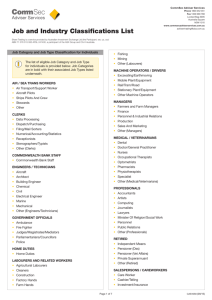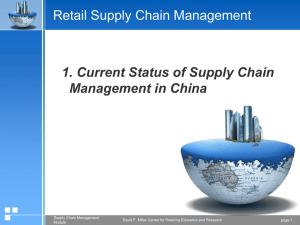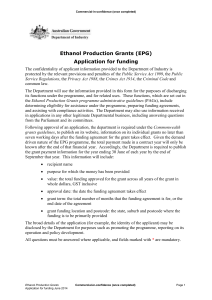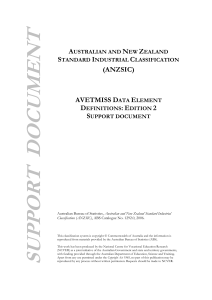kotler15exs-Managing Retailing, Wholesaling, and Market Logistics
advertisement
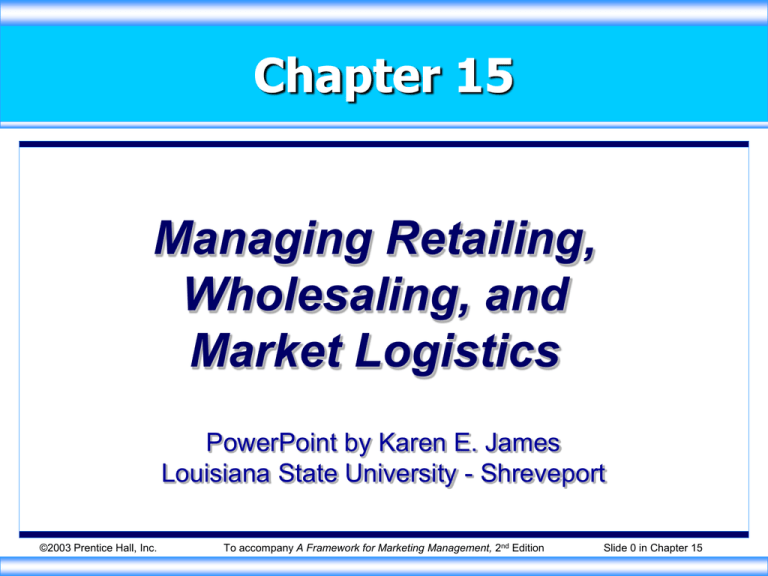
Chapter 15 Managing Retailing, Wholesaling, and Market Logistics PowerPoint by Karen E. James Louisiana State University - Shreveport ©2003 Prentice Hall, Inc. To accompany A Framework for Marketing Management, 2nd Edition Slide 0 in Chapter 15 Objectives Determine the types of organizations in this sector. Learn what marketing decisions organizations in this sector make. Understand the major trends in this sector. ©2003 Prentice Hall, Inc. To accompany A Framework for Marketing Management, 2nd Edition Slide 1 in Chapter 15 Retailing Retailing Basics Retail life cycle Wheel-of-retailing Types of retailers Service levels Marketing decisions Retail positioning strategies Retailing trends ©2003 Prentice Hall, Inc. Nonstore retailing Corporate retailing To accompany A Framework for Marketing Management, 2nd Edition Slide 2 in Chapter 15 Retailing Major Store Retailer Types Specialty store Discount store Department store Convenience store Supermarket Off-price retailer Superstore ©2003 Prentice Hall, Inc. To accompany A Framework for Marketing Management, 2nd Edition Slide 3 in Chapter 15 Retailing Retail-store types pass through the retail life cycle. The wheel-of-retailing describes how new store types emerge. Retailers can offer one of four levels of service: – Self-service, self-selection, limited service, and full service ©2003 Prentice Hall, Inc. To accompany A Framework for Marketing Management, 2nd Edition Slide 4 in Chapter 15 Retailing Four broad retail positioning strategies include: – Bloomingdale’s – Tiffany – Sunglass Hut – Wal-Mart Non-store retailing has been growing faster than store retailing ©2003 Prentice Hall, Inc. To accompany A Framework for Marketing Management, 2nd Edition Slide 5 in Chapter 15 Retailing Major Types of Retail Organizations Corporate chain store Consumer cooperative Voluntary chain Franchise organization Retailer cooperative Merchandising conglomerate ©2003 Prentice Hall, Inc. To accompany A Framework for Marketing Management, 2nd Edition Slide 6 in Chapter 15 Retailing Retailing Basics Types of retailers Marketing decisions Retailing trends Target market Product assortment and placement Services mix and store atmosphere Price Promotion Place ©2003 Prentice Hall, Inc. To accompany A Framework for Marketing Management, 2nd Edition Slide 7 in Chapter 15 Retailing Location Options for Retailers General business district Strip mall (shopping strip) Regional shopping center Location within a larger store or operation Community shopping center ©2003 Prentice Hall, Inc. To accompany A Framework for Marketing Management, 2nd Edition Slide 8 in Chapter 15 Retailing Retailing Basics Types of retailers New retail forms Intertype competition Growth of giant retailers Marketing decisions Technology Retailing trends Competition between store-based and nonstore-based retailing ©2003 Prentice Hall, Inc. Global expansion Selling experiences To accompany A Framework for Marketing Management, 2nd Edition Slide 9 in Chapter 15 Wholesaling Wholesaling Wholesaling basics Types of wholesalers Marketing decisions Wholesaling trends ©2003 Prentice Hall, Inc. Wholesaling excludes manufacturers, farmers, and retailers Wholesalers differ from retailers in three key ways Wholesalers handle many functions more efficiently than do manufacturers To accompany A Framework for Marketing Management, 2nd Edition Slide 10 in Chapter 15 Wholesaling Wholesaler Functions Selling and promoting Buying and assortment building Bulk breaking ©2003 Prentice Hall, Inc. Warehousing Transportation Financing Risk bearing Market information To accompany A Framework for Marketing Management, 2nd Edition Slide 11 in Chapter 15 Wholesaling Wholesaling Wholesaling basics Growth and types of wholesalers Marketing decisions Wholesaling trends ©2003 Prentice Hall, Inc. Wholesalers vary in type and function Wholesaling has been growing due to two key factors: – Many factories are located far from buyers – An increasing need to adapt product quantities, features, or packages to meet buyer needs To accompany A Framework for Marketing Management, 2nd Edition Slide 12 in Chapter 15 Wholesaling Major Wholesaler Types Merchant wholesalers Full-service wholesalers Limited-service wholesalers Brokers & agents ©2003 Prentice Hall, Inc. Brokers Agents Manufacturers’ and retailers’ branches and offices Miscellaneous wholesalers To accompany A Framework for Marketing Management, 2nd Edition Slide 13 in Chapter 15 Wholesaling Wholesaling Wholesaling basics Target market Product assortment and placement Types of wholesalers Price Marketing decisions Place Promotion Wholesaling trends ©2003 Prentice Hall, Inc. To accompany A Framework for Marketing Management, 2nd Edition Slide 14 in Chapter 15 Wholesaling Wholesaling Wholesaling basics Types of wholesalers Marketing decisions Wholesaling trends ©2003 Prentice Hall, Inc. Direct buying trends initially threatened wholesalers Wholesalers have adapted by: – Adding value – Reducing costs – Strengthening relationships with manufacturers To accompany A Framework for Marketing Management, 2nd Edition Slide 15 in Chapter 15 Market Logistics Interrelated Aspects Associated with Market Logistics: – Physical distribution – Supply chain management (SCM) – Value network – Demand chain planning – Market logistics – Integrated logistics systems (ILS) ©2003 Prentice Hall, Inc. To accompany A Framework for Marketing Management, 2nd Edition Slide 16 in Chapter 15 Market Logistics Key Elements Market-logistics objectives Market-logistics decisions Market logistics lessons ©2003 Prentice Hall, Inc. Logistics involve tradeoffs between costs and customer service Maximizing profits, not sales, is key A total system basis should be considered Designing a system that will minimize the cost of achieving objectives should be the outcome To accompany A Framework for Marketing Management, 2nd Edition Slide 17 in Chapter 15 Market Logistics Calculating the Cost of Market-Logistics Systems M = T + FW + VW + S Where . . . M = total market-logistics cost of proposed system; T = total freight cost of proposed system; FW = total fixed warehouse cost of proposed system; VW = total variable warehouse cost of proposed system S = total cost of lost sales due to average delivery delay ©2003 Prentice Hall, Inc. To accompany A Framework for Marketing Management, 2nd Edition Slide 18 in Chapter 15 Market Logistics Key Elements Market-logistics objectives Market-logistics decisions Market logistics lessons ©2003 Prentice Hall, Inc. Order processing Warehousing – Storage, distribution, automated warehouses Inventory – Determine reorder point, relevant cost comparison, optimal order quantity Transportation – Containerization – Private vs. contract carriers To accompany A Framework for Marketing Management, 2nd Edition Slide 19 in Chapter 15 Market Logistics Key Elements Market-logistics objectives Market-logistics decisions Market logistics lessons ©2003 Prentice Hall, Inc. A senior V.P. is needed as the single contact point for all logistical elements Senior V.P. must maintain close control Software and systems are essential for competitively superior logistics performance To accompany A Framework for Marketing Management, 2nd Edition Slide 20 in Chapter 15
